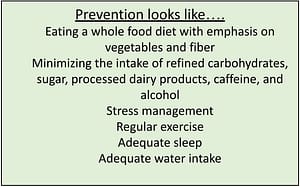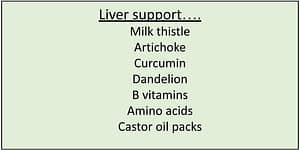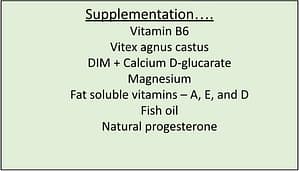| Written by: Dr. Alice Veirs |
In the second part of the series, I am going to discuss the ins and outs of the most common menstrual complaint, premenstrual syndrome (PMS).
PMS is a complex syndrome with not only biological causes but cultural and emotional ties that interplay and contribute to its normalization. New data reveals that up to 90% of menstruating women report premenstrual symptoms of which 20-40% report moderate difficulties and 2-5% experience notable negative impacts on their lives. Some of these more severe cases may be attributed to premenstrual dysphoric disorder (PMDD), which will be covered in a future blog post.
PMS symptoms may start at the end of the follicular phase, as soon as ovulation happens, but usually occur the last week of the menstrual cycle. Symptoms soon dissipate once your period starts. It is important to be aware of the timing of your symptoms because it is not PMS if symptoms do not occur in this cyclical pattern. You may find you can predict the onset of your symptoms. Your healthcare provider may ask you to track your cycle in order to confirm a diagnosis of PMS.
PMS symptoms may be emotional or physical. The most common symptoms are…
- Mood swings
- Irritability
- Anxiety
- Depression/weepiness
- Fatigue/lethargy
- Food cravings/increase in appetite
- Forgetfulness/brain fog
- Migraines/headaches
- Acne
- Bloating
- Weight gain
- Constipation/diarrhea
- Cramps
- Back pain
- Breast tenderness
- Joint pain or swelling
Causes of PMS symptoms
If you go back to the hormone graph exhibited in the first part of this series, you can see that estrogen and progesterone naturally rise and fall during a menstrual cycle. The normal decrease in hormones after ovulation is thought to cause the typical PMS symptoms you may experience. If you have excess estrogen in your body, this decrease is exacerbated, and symptoms may be more severe. High levels of estrogen can occur for multiple reasons. Environmental estrogens exist in many products and foods we are exposed to daily. Birth control pills also lead to elevated estrogen. Low clearance of estrogen from our bodies occurs from constipation and liver disorders. Increased fat tissue leads to high amounts of internal estrogen due to fat’s ability to create its own estrogen. Low progesterone can also cause an estrogen-excess like syndrome.
Other contributing disorders
- Hypothyroidism
- Neurochemical imbalances (such as low serotonin)
- High prolactin
- Nutritional imbalances
- HPA axis dysfunction (high cortisol)
- Glucose dysregulation (high insulin)
- Insomnia
Many pre-existing conditions can have similar or possibly worsen PMS symptoms. A comprehensive medical intake including lab work up should be done by your physician to aid in a differential diagnosis of PMS.
Treatments for PMS Symptoms
Since PMS is traditionally self-treated at home this provides a lot of opportunity for natural treatments. Conventional allopathic doctors often only offer pharmaceutical treatments that come with a host of side effects. One naturopathic principle that works particularly well for PMS is prevention. If we can address the cause of symptoms at the beginning of the menstrual cycle, then PMS may be prevented. Or at least reduced in severity.

(Preventative approaches can reduce or eliminate unwanted PMS symptoms)
Studies have shown that most women suffering with PMS have diets higher in refined carbohydrates, saturated fat, sugar, and dairy than women without PMS. Reducing your intake of these foods has several effects; mitigates spikes in insulin which lead to fat deposition, lowers inflammatory arachidonic acid that contributes to menstrual cramps, and lowers sodium which leads to water retention and bloating. Emphasizing whole foods, especially vegetables and complex carbohydrates, adds in vital nutrients to your diet. This in turn supports optimal liver function and provides adequate fiber that helps regulate bowel movements, leading to proper hormone metabolism.

(Liver support options for treating PMS symptoms)
Getting regular exercise and adequate sleep helps reduce stress and improves stress response. This in turn improves serotonin and cortisol levels, which leads to better insulin regulation, less fat deposition, and a reduction in estrogen. Stress management techniques can also help regulate stress response, lower cortisol, and improve mood.
The liver is your main organ of detoxification. Enzymes in the liver metabolize estrogen into a form that is easily excreted in urine and feces. By optimizing liver function, a subsequent reduction in estrogen will follow. Although this has been difficult to show scientifically, an increase in estrogen in liver disease has been observed. The list above contains herbs that all have properties that protect and nourish the liver. B-vitamins and amino acids are essential in the function of liver enzymes and help to create new enzymes. A castor oil pack is a traditional nature cure technique that reduces inflammation. They are usually applied over the liver but can be applied to the pelvis or entire abdomen as well.
There are many treatments that are used clinically for PMS. Let’s look at some of my favorite supplements!

(Dr. Veirs top supplements for PMS symptoms)
Vitamin B6 has been shown in many studies to relieve symptoms of PMS. Clinicians believe that it helps increase levels of neurotransmitters (dopamine, serotonin, norepinephrine, epinephrine, taurine, and histamine). These are often observed as being low in those with PMS.
Fat soluble vitamins and fish oil all play a role in synthesis of prostaglandins. These substances reduce the formation of inflammatory prostaglandins and increase the formation of anti-inflammatory prostaglandins. This can reduce headaches, menstrual cramps, breast tenderness, and tension. Additionally, each fat-soluble vitamin has many more beneficial effects outside of prostaglandins synthesis.
Vitex is an herb that modulates hormones, specifically helps in raising progesterone.
DIM + calcium D-glucarate both modulate the metabolism of estrogen and are thought to increase the excretion of estrogen, especially the most harmful version (estrone). By combining Vitex, DIM, and calcium D-glucarate you can effectively raise your progesterone and lower your estrogen, which as we discussed above is often the culprit in PMS.
Magnesium is a wonderful addition for women experiencing PMS for several reasons. Many women with PMS are not getting enough magnesium in their diets. Magnesium helps relieve tension, it has a calming effect on the nervous system, and can relieve constipation (which can lead to increased estrogen). Magnesium also plays a role in neurotransmitter synthesis (works with B6) and essential fatty acid metabolism which both help reduce several symptoms of PMS. Magnesium glycinate is thought to be the most calming and one of the better absorbed forms but other forms are beneficial.
The use of natural progesterone is thought to balance high levels of estrogen that lead to PMS symptoms. This therapy is usually used last when other treatments have failed and should only be used after blood work has been done to check hormone levels. Natural progesterone can be found over the counter or be prescribed by a physician. Likely only a naturopath will prescribe a bio-identical form of progesterone instead of synthetic.
You don’t have to suffer from PMS. Talk to one of our naturopaths today!
If you would like to discuss any of this information, you can schedule a free meet and greet with our naturopathic doctors by calling 480-256-2999 or texting 480-256-2829.

